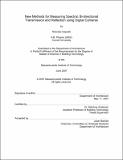New methods for measuring spectral bi-directional transmission and reflection using digital cameras
Author(s)
Gayeski, Nicholas (Nicholas Thomas)
DownloadFull printable version (4.628Mb)
Other Contributors
Massachusetts Institute of Technology. Dept. of Architecture.
Advisor
Marilyne Anderson.
Terms of use
Metadata
Show full item recordAbstract
Advanced fenestration systems are increasingly being used to distribute solar radiation purposefully in buildings. Distribution of visible light and near infrared radiation can be optimized to enhance daylighting and reduce thermal loads. Light redirecting window systems are one of many innovative fenestration systems available for improving the daylighting and thermal performance of buildings. Many emerging and existing light redirecting systems have both spectrally and angularly selective optical properties. To study these properties, a device that measures the spectral, bi-directional transmission and reflection distribution functions of complex fenestration systems is being developed at the Massachusetts Institute of Technology. This device, a goniophotometer, will measure photometric and radiometric BT(R)DFs for radiation of 380 to 1700 nanometer wavelengths, encompassing much of the solar spectrum. The device incorporates spectroradiometrically calibrated digital cameras and absorption filters to gather quasi-spectral information about reflection and transmission by complex fenestration systems. It relies on a half-mirrored, aluminum coated acrylic hemi-ellipsoid to project reflected or transmitted light towards a digital camera. (cont.) The device will be able to characterize BT(R)DFs for a variety of fenestration system materials, assemblies, and building materials. The goal of this research is to support the development of innovative, spectrally and angularly selective window systems that can improve daylighting and comfort and/or reduce cooling and heating loads in buildings. This thesis focuses on calibrating digital cameras to measure radiances with unknown spectra, developing the hemi-ellipsoid for the new goniophotometer, and developing methods for constructing quasi-spectral BT(R)DFs using this new device. The calibrated cameras also have potential for use in other applications, for example, as radiometers and photometers in rooms with light of known spectra.
Description
Thesis (S.M.)--Massachusetts Institute of Technology, Dept. of Architecture, 2007. This electronic version was submitted by the student author. The certified thesis is available in the Institute Archives and Special Collections. Includes bibliographical references (p. 194-201).
Date issued
2007Department
Massachusetts Institute of Technology. Department of ArchitecturePublisher
Massachusetts Institute of Technology
Keywords
Architecture.